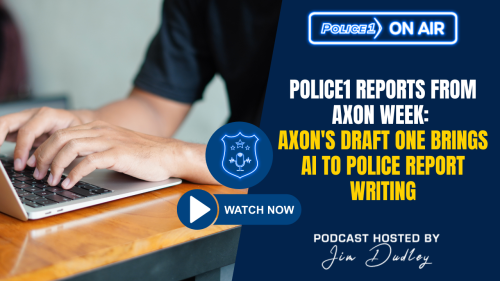By Jim Dudley
“It was such an enjoyable experience writing a police report!” said no one ever … that is until now.
Law enforcement agencies have used various iterations of dictation to assist officers in writing police reports. Some are better than others, but the process still requires the officer to respond to the scene, take all the information from the witness or victim, jot it into a notebook and return to the station, then repeat the series of events on a recording device or via phone to a dictation service.
This duplication of effort doesn’t save much time throughout the process. Enter Axon’s Draft One. This system of report writing uses audio from an officer’s body-worn camera (BWC) and, with AI assistance, creates a draft report for the officer.
How does Draft One work?
The BWC audio is uploaded into the cloud and is ready for the Draft One software to do its job while the officer returns to the station or prepares the report in the field. The author selects the relevant video(s) for the report and then clicks a button to generate the first draft. The author then reviews the report and adds pertinent details not mentioned in the audio, and adds or corrects other information. Draft One gives prompts on possible errors or omissions, such as a missing point of entry, piece of evidence or elements of the crime. The writer then reviews the final draft carefully and attests to the veracity, as with traditional reports. It should be emphasized that Draft One takes its cues from the BWC audio only and does not fill in gaps, create content on its own, or use a template format. The idea of AI creating a report from scratch does not happen with this system.
Early adopters say that officers enjoyed the experience and even adjusted to add more to the reports generated from the BWC audio. Some officers began to narrate activities that would not be contained on the BWC. For example: “As I pulled up, I noticed a blue Pontiac sedan, license plate ABC 123 parked diagonally across the lawn.” Or “I noticed the reportee/victim had swelling under her right eye and there appeared to be blood on the collar of her shirt…”
This makes sense, as the officers will adjust to the system to their advantage, making notes of information (signs, license plates, etc.) that may not be audibly recorded and taking note of both visual and non-verbal body language and cues (“suspect balled his fists and took a fighting stance” or “the witness nodded their head, indicating the person to their left was the suspect”).
Benefits of Draft One
Axon’s Noah Spitzer-Williams, senior principal AI product manager, and representatives from police agencies who were early adopters of the system verified the ease of use and how officers have adapted to using Axon’s Draft One, citing time savings of half the time of traditional report writing. The benefits are better reports, quicker reports, improved officer morale and getting cops back out on the street, rather than spending hours working on reports.
As initial use by agencies increases, Axon recommends against Draft One as the first introduction to report writing for recruits but rather build it into foundational skills after field training. Still, the possibilities exist to use Draft One reports as examples of how individual departments choose to assemble their reports (i.e., first person-third person narratives, chronological order of events, notifications, etc.).
For more information, visit https://www.axon.com/products/draft-one.
NEXT: Tune in to the Policing Matters podcast to hear from Noah Spitzer-Williams, Axon’s senior principal product manager, as he discusses how Draft One improves efficiency, accuracy and officer morale.





